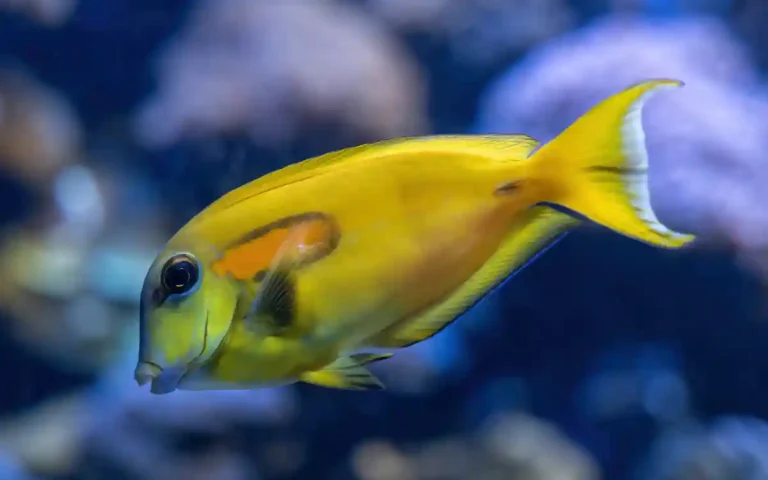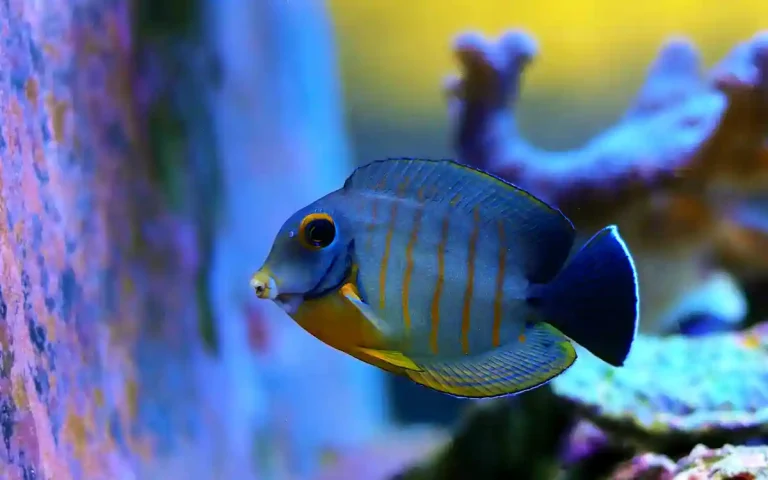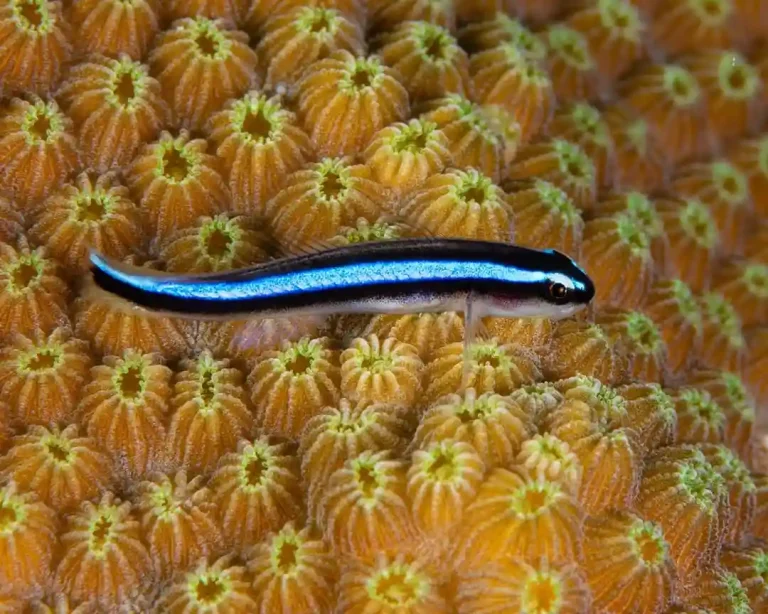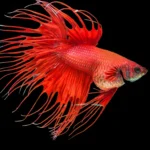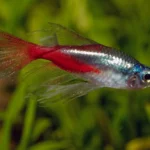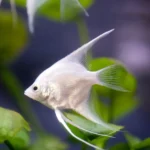The Royal Gramma (Gramma loreto) is one of the most popular choices for saltwater aquarium keepers and for good reason. With its vibrant purple-to-yellow gradient and peaceful nature, this fish brings color and calm to almost any marine setup. It’s reef-safe, beginner-friendly, and well-suited for nano tanks or larger community aquariums. If you’re starting a saltwater tank or just looking to add a reliable tank mate, the Royal Gramma deserves your attention.
Quick Species Profile
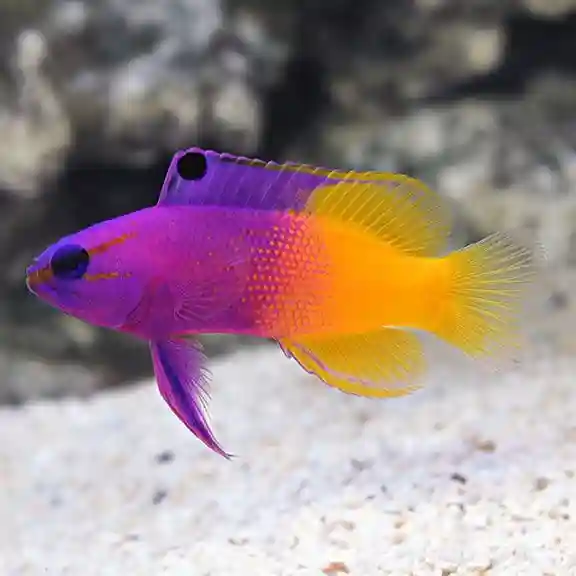
| Trait | Details |
| Common Name | Royal Gramma |
| Scientific Name | Gramma loreto |
| Origin | Caribbean Sea |
| Maximum Size | Around 3 inches |
| Lifespan | 5–7 years |
| Temperament | Peaceful, cave-dwelling |
| Diet | Carnivorous |
| Tank Size | Minimum 20 gallons |
| Reef-Safe | Yes |
| Care Level | Easy |
Appearance and Behavior
The Royal Gramma is instantly recognizable. Its front half glows with deep purple, gradually fading into a brilliant yellow toward the tail—a perfect palette for reef aesthetics. Unlike many flashy saltwater fish, the Royal Gramma is not aggressive or high-maintenance. It’s a shy, cave-loving species that prefers to hover near rock structures or within overhangs. Most of the time, it will claim a specific hiding spot and dart out during feeding or brief moments of curiosity.
Though generally peaceful, this fish may display territorial behavior if another fish of similar shape or color enters its personal zone. For small aquariums, it’s best to keep just one to avoid potential disputes.
Ideal Tank Setup
Royal Grammas are flexible and adaptable, which makes them ideal for both beginners and experienced aquarists. A tank size of at least 20 gallons is suitable for a single individual. However, a 30-gallon or larger tank gives it more space to roam and reduces stress.
The key to a happy Royal Gramma is aquascaping. These fish thrive in setups with live rock, caves, and ledges where they can retreat when feeling insecure. Avoid bare tanks or minimal decorations—this fish needs structure to feel safe.
Water conditions should remain stable. Aim for a temperature between 72–78°F, pH between 8.1–8.4, and a salinity range of 1.020–1.025. Use a reef-safe protein skimmer or filter and ensure moderate water flow. While they don’t demand intense lighting, blue LED lights can help bring out their vibrant coloration, especially during the evening hours.
Feeding and Diet
Royal Grammas are carnivorous and enjoy a varied diet of meaty foods. In the wild, they feed on zooplankton and small crustaceans. In captivity, they readily accept frozen mysis shrimp, brine shrimp, and high-quality marine pellets.
Feeding once or twice daily is enough. It’s best to serve in small amounts that the fish can consume within a couple of minutes. Occasional treats like chopped krill or copepods can add variety and support their immune system. A varied diet helps keep their colors vibrant and energy levels high.
Compatibility and Tank Mates
Thanks to their calm temperament, Royal Grammas make excellent community tank residents. They coexist peacefully with most reef-safe species and don’t bother corals or invertebrates. Good tank mates include clownfish, firefish, gobies, cardinalfish, and small wrasses. Dwarf angelfish can also be suitable if the tank is large enough and territories don’t overlap.
It’s important to avoid pairing Royal Grammas with other fish of the same genus unless the tank is spacious and full of hiding spots. In small tanks, they can become territorial toward similar-looking species, especially other basslets or dottybacks. Aggressive or predatory fish—such as large groupers or lionfish—should also be avoided, as they may view the Gramma as food.
Lifespan and Health
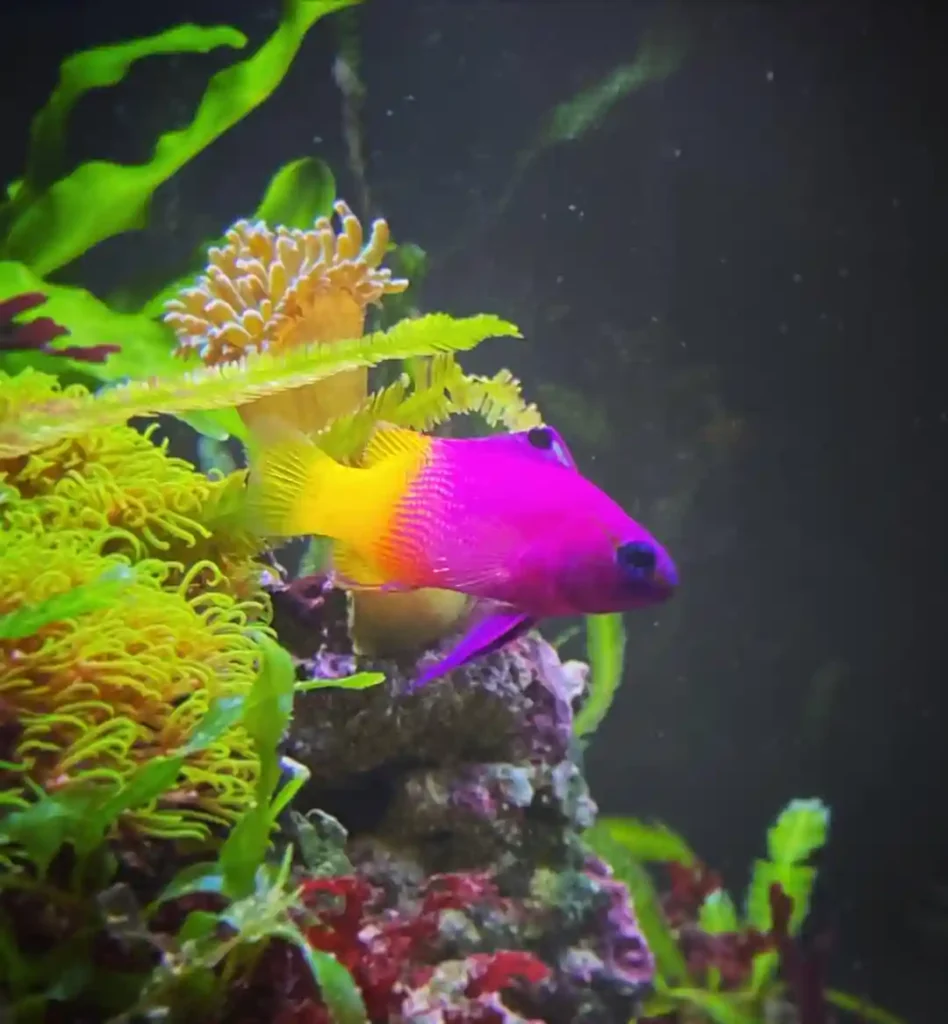
With proper care, a Royal Gramma can live between five to seven years, sometimes longer. Their hardiness is one of their biggest advantages, making them a reliable choice for both beginners and seasoned reef-keepers.
Still, like all saltwater fish, they’re susceptible to stress-related illnesses, especially marine ich. Most health problems stem from unstable water conditions or overcrowded tanks. A good practice is to quarantine new fish and corals before introducing them into the main tank. Routine water testing and weekly maintenance go a long way in preventing disease outbreaks.
Signs of a healthy Royal Gramma include bright coloration, active but calm swimming, and regular feeding. If the fish begins hiding excessively or shows signs of discoloration, investigate water parameters immediately.
Breeding in Captivity
Breeding Royal Grammas in home aquariums is rare, but not impossible. In the wild, they are known to form monogamous pairs and spawn in caves. The male guards the eggs, which are usually laid on the roof of their cave hideout.
Reproducing them in captivity requires dim lighting, high water quality, and minimal disturbance. If you’re serious about breeding, provide ample rockwork to encourage pair bonding and spawning behavior. Conditioning both fish with protein-rich diets may help trigger mating, though success often depends on tank size and individual compatibility.
While not recommended for casual hobbyists, attempting to breed them can be a rewarding challenge for experienced aquarists.
Is the Royal Gramma Right for You?
If you’re searching for a colorful, reef-safe fish that doesn’t require expert-level care, the Royal Gramma is a top-tier choice. Its small size, peaceful behavior, and ability to adapt to nano or community reef tanks make it a smart addition to most marine aquariums.
You’ll enjoy its quirky habits—popping in and out of rockwork—and its bold coloration under LED lighting. Just be sure to provide a cave to call home, a stable environment, and a protein-rich diet. With those basics in place, this little gem will thrive for years.
FAQs
Can I keep multiple Royal Grammas together?
Not in small tanks. They may fight over territory. In large tanks (55+ gallons) with multiple hiding spots, a bonded pair might coexist peacefully.
Is the Royal Gramma aggressive?
Generally, no. It’s shy and peaceful, but may act territorial if confined or challenged by a similarly shaped fish.
Does it jump out of the tank?
Yes. They are known to jump if startled. A tight-fitting lid or mesh top is highly recommended.
Is it reef-safe?
Absolutely. The Royal Gramma does not bother corals or invertebrates, making it an excellent reef tank resident.
How often should I feed it?
Once or twice a day, in small portions. Offer a mix of frozen foods, pellets, and occasional treats.
Final Thoughts
The Royal Gramma stands out as one of the most rewarding saltwater fish to own. It checks nearly every box: beauty, compatibility, ease of care, and long-term health when properly housed. Whether you’re building a nano reef or expanding a mid-sized tank, this fish brings color and life without the stress. Give it the right home, and it’ll reward you with years of peaceful, radiant presence.

